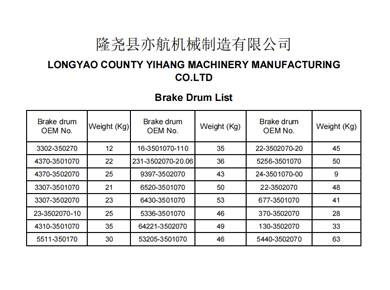nov . 24, 2024 18:20 Back to list
brake drum removal tips
Tips for Removing Brake Drums
Removing brake drums is a crucial process for anyone involved in vehicle maintenance or repair. Whether you're a seasoned mechanic or a DIY enthusiast, understanding the right techniques can save time and ensure safety. In this guide, we’ll share valuable tips for removing brake drums effectively.
Safety First
Before you begin any automotive work, safety should always be your top priority. Ensure that your vehicle is on a stable, flat surface and that you have the necessary tools at hand. You'll need a lug wrench, brake drum puller, a bungee cord or strap, and some basic hand tools. Additionally, wearing safety glasses and gloves can help protect you from debris and sharp edges.
Preparing the Vehicle
1. Loosen the Lug Nuts Start by slightly loosening the lug nuts on the wheel of the brake drum you plan to remove. Do this while the wheel is still on the ground to prevent it from spinning. Turn the lug nuts counterclockwise, but don’t remove them completely just yet.
2. Lift the Vehicle Use a jack to lift the vehicle off the ground. Once it’s elevated adequately, secure it with jack stands for added safety. This will give you enough clearance to work comfortably.
3. Remove the Wheel Now, completely unscrew the lug nuts and remove the wheel to expose the brake drum.
Assessing the Brake Drum
Before proceeding with drum removal, examine the brake components for any issues. Look for signs of wear on the brake shoes and inspect the condition of the drum itself. If you notice any significant wear or damage, it might be worth considering replacing them rather than just removing the drum.
Removing the Brake Drum
brake drum removal tips

1. Check for Retaining Clips Some brake drums have retaining clips or screws that may need to be removed before you can take the drum off. Make sure to remove these components carefully to avoid damaging them.
2. Use a Brake Drum Puller If the brake drum doesn’t budge, a brake drum puller can be an invaluable tool. This tool applies even pressure around the drum, helping to break the friction seal that may have formed over time. Follow the manufacturer’s instructions for using the puller to ensure effective and safe removal.
3. Gentle Taps If you don’t have a puller, you can try tapping around the drum's edge with a rubber mallet. Be careful not to hit too hard, as this can damage the drum or the brake components.
4. Wiggle the Drum Sometimes, a little coaxing is needed. Gently wiggle the drum back and forth to help free it from its position. If it still doesn’t move, re-evaluate if all components, including clips, have been removed.
Inspecting and Cleaning
Once the brake drum is removed, take time to inspect it along with the brake shoes. Look for uneven wear and any signs of damage. Cleaning the drum and the surrounding components is also a good idea at this stage. Use brake cleaner to remove dust and debris, and check for any rust or corrosion that might need to be addressed.
Reassembly
When you’re ready to reassemble, follow the steps in reverse order. Replace the brake drum (or install a new one if needed), secure it properly, and ensure any retaining clips are reattached. Reinstall the wheel, hand-tighten the lug nuts, lower the vehicle, and finally, tighten the lug nuts securely in a crisscross pattern to ensure even distribution.
Conclusion
Removing brake drums doesn’t have to be a daunting task. By following these tips and paying attention to safety, you can effectively manage the process. Always remember to assess the condition of the components and take your time to ensure everything is done correctly. Whether it's routine maintenance or repairs, being knowledgeable about brake system components will enhance your confidence and skills as a vehicle owner or mechanic. Happy wrenching!
-
FRUEHAUF AI Trailers with GPT-4 Turbo Innovation
NewsAug.02,2025
-
TATRA: Supercharge AI with GPT-4 Turbo Technology
NewsAug.01,2025
-
2014 Mitsubishi Mirage Rear Brake Drums | Durable & Precise
NewsJul.31,2025
-
High-Quality Trailers for Towing Needs | Shop Now
NewsJul.25,2025
-
Premium MAN Shaving Kit for Effortless Comfort
NewsJul.25,2025
-
HINO Advanced Machinery Solutions - LONGYAO COUNTY YIHANG MACHINERY | Industrial Efficiency&Customization
NewsJul.21,2025
